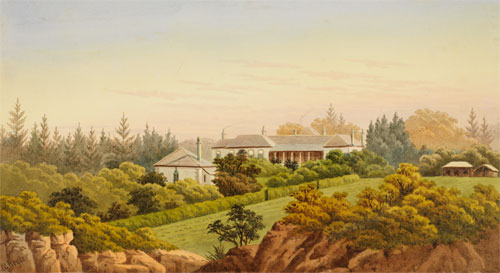Esther Johnston, first lady

Annandale House, Johnstone Estate, by J. C. Hoyte. Watercolour. DG V1A / 9
Esther Johnston’s story is a classic tale of rags to riches and back again. Esther rose from the lowly status of a convict girl to 'first lady' of New South Wales, successfully managing properties in early Sydney until a family dispute left her with nothing.
Esther Abrahams was about fifteen years old and may have been pregnant when she was charged with stealing lace from a London draper's shop on 27 July 1786. At her trial at the Central Criminal Court (Old Bailey), Esther was sentenced to seven years' transportation. She travelled on board the Lady Penrhyn in the First Fleet, and arrived to help establish the new colony of New South Wales with baby Rosanna in her arms. On board the Lady Penrhyn, she had commenced a relationship with Lieutenant George Johnston of the Royal Marines. The relationship prospered, and the couple had seven children together by 1806.
Esther adopted the surname Julian around 1800. The reasons for this are unclear, but it may have been the surname of the man who had fathered Rosanna. George Johnston finally married Esther in 1814, possibly under the influence of governor Lachlan Macquarie who was keen to see long-term relationships become legitimate marriages under Church of England rites. By this time George had become a legendary figure in New South Wales. He had spent time as an officer on Norfolk Island, commanded a company in the New South Wales Corps, had helped put down a rebellion of Irish convicts at Castle Hill in 1804, and was a key figure in the overthrow of governor William Bligh in 1808. Major George Johnston then became lieutenant-governor, meaning that Esther assumed the unofficial role of first lady of New South Wales and performed vice-regal duties with her husband. Johnston was tried in London for his role in Bligh’s overthrow, and was absent from the colony for four years. In this time, Esther successfully managed Johnston’s large estates: Annandale (named after Johnston’s birthplace in Scotland) and George’s Hall, near Bankstown. She oversaw the convict servants, managed the finances of both properties and sold meat and grain to the government stores.
Following George Johnston’s death in 1823, the Annandale Estate was bequeathed to Esther on the understanding that it would transfer to their son Robert on Esther’s death. George's Hall, meanwhile, was bequeathed to son David. Robert Johnston was most unhappy with this situation, and claimed in 1829 that Annandale was in decline under his mother’s management. A very public trial ensued, at which it was claimed that Esther's mental health had declined and that she had become an alcoholic since George’s death. Esther was officially declared 'not of sound mind, nor capable of managing her affairs', and the property became Robert's. Esther lived the rest of her life at George's Hall, dying there on 26 August 1846. She was buried on the Annandale Estate, in accordance with her late husband's wishes, and her remains are now in the Johnston family vault at Waverley Cemetery.
The extent to which Esther's Jewish faith impacted on her life in Australia is unknown. However, Esther's grandson George Robert Nichols – son of Rosanna – was a lawyer and politician who forcefully argued that the colony's Jews and Christians should receive equal amounts of government assistance for public worship. Thanks to his efforts in 1853, the minister of the Sydney Hebrew Congregation was paid a stipend of £200 from government coffers.
P. L. Bemi, Map of the Estate named Annandale situate in the Parish of Petersham and District of Sydney the property of Robert Johnston Esq. R.N. 1843. ms. map. Z/M3 811.1823/1843/4

